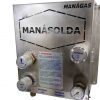
Complete Guide to Gas Mixers and its various applications
How to reduce welding processes costs by lowering shielding gases costs?
WELDING PROCESSES X SHIELDING GASES
*Check spreadsheet below
The use of shielding gases to optimize the atmosphere in welding processes, whether MIG/MAG (GMAW) or TIG (GTAW), has numerous benefits and technical advantages.
There is no doubt about it.
However, when comparing the cost of mixing commercial gas for welding, for example C25 mixture (25% CO2 in balance with Argon), with the cost of pure Argon, we note that the technical advantages represent a greater expense and may be more expensive the cost of your welding product or service.
Naturally, the cost of pure gas or gas mixture depends on a number of factors, such as the monthly volume consumed, distance to the supplier and type of supply.
Therefore, for welding processes, the ideal scenario would be to have the productivity, protection, less amount of spatter, … finally, the benefits that a mixture of gases provides the weld and at the same time, being able to work with the cost of pure gas.
This is exactly the advantage that a gas mixer represents.
See the spreadsheet below, which compares the cost of consuming commercial gas mixtures (ready-made) and the cost of installing a gas mixer in your factory and producing your own mixtures.
Number of Welders
2
Weekly Consumption (m³)
45,30696
Number of C25 gas mix cylinders per week
4,530696
Premixed gas mixture cost i.e. C25
€ 181,23
Gas Mixture cost using MANÁSOLDA
€ 118,93
Weekly Savings
€ 62,30
Annual Savings
€ 3.239,45
Number of Welders
5
Weekly Consumption (m³)
113,2674
Number of C25 gas mix cylinders per week
11,32674
Premixed gas mixture cost i.e. C25
€ 453,07
Gas Mixture cost using MANÁSOLDA
€ 297,33
Weekly Savings
€ 155,74
Annual Savings
€ 8.098,62
Number of Welders
8
Weekly Consumption (m³)
181,22784
Number of C25 gas mix cylinders per week
18,122784
Premixed gas mixture cost i.e. C25
€ 724,91
Gas Mixture cost using MANÁSOLDA
€ 475,72
Weekly Savings
€ 249,19
Annual Savings
€ 12.957,79
Number of Welders
10
Weekly Consumption (m³)
226,5348
Number of C25 gas mix cylinders per week
22,65348
Premixed gas mixture cost i.e. C25
€ 906,14
Gas Mixture cost using MANÁSOLDA
€ 594,65
Weekly Savings
€ 311,49
Annual Savings
€ 16.197,24
Number of Welders
15
Weekly Consumption (m³)
339,8022
Number of C25 gas mix cylinders per week
33,98022
Premixed gas mixture cost i.e. C25
€ 1.359,21
Gas Mixture cost using MANÁSOLDA
€ 891,98
Weekly Savings
€ 467,23
Annual Savings
€ 24.295,86
Values adopted in the Cost estimation above
1) Consumption of 45 m³ per week
2) 50% Operating Factor
3) 40 hours week
4) Pure CO2 cost of EUR 1,5/m³
5) Pure Argon cost of EUR 3/m³
6) C25 mixture cost of EUR 4/m³
CONCLUSION
Considering only 05 welders with an operating factor of 50% per week, the installation of a gas mixer to feed the welding stations, can mean annual savings of approximately EUR 12,700.
Operations with more welding professionals may have even greater optimizations.
In addition to the financial benefit, installing a gas mixer also makes your process more flexible, as the gas mix can be changed dynamically.
Additionally, it minimizes the time for changing cylinders and setting time for welding parameters, thus maximizing welding time.
QUESTIONS related to “HOW TO REDUCE WELDING PROCESSES COSTS BY LOWERING SHIELDING GASES COSTS?”
Any questions and comments related to “HOW TO REDUCE WELDING PROCESSES COSTS BY LOWERING SHIELDING GASES COSTS?”, please feel free contact us at any time. In addition, please take this opportunity to explore our product line of high performance gas mixers for TIG welding (GTAW welding).

Gas mixer designed and manufactured for the welding process, which allows mixing between 02 gases, with flow rate and outlet pressure control. From 0 to 100% content adjustable gas mixing output.

Compact gas mixer designed and manufactured for the welding process, which allows mixing between 02 gases, with outlet flow rate control. From 0 to 100% content adjustable gas mixing output. Requires cylinder/first stage pressure regulators for both input gases.
